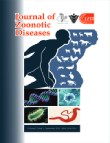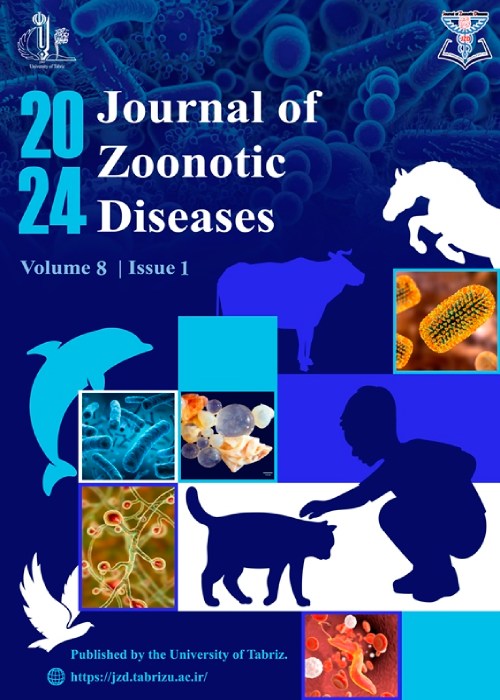فهرست مطالب

Journal of Zoonotic Diseases
Volume:7 Issue: 2, Spring 2023
- تاریخ انتشار: 1402/03/11
- تعداد عناوین: 6
-
-
Pages 250-259
The rapid and unpleasant spread of pathogens was exemplified by the COVID-19 pandemic. Throughout history, humans and animals have been affected by numerous significant epidemics and pandemics, including but not limited to the plague, SARS, MERS, H1N1 pandemic influenza, H5N1 avian influenza, and Ebola hemorrhagic fever. Human diseases are mainly caused by animal-human transmission. The COVID-19 pandemic caused by the SARS-CoV-2 virus is the most destructive pandemic of the current century. About 3/4 of all re-emerging and arising human diseases may date back to animals, mainly wild animals. The SARS-CoV-2 virus has been identified as a global health concern as it affects not only humans but also pets and a variety of wild and domestic animals. This finding emphasizes the significant impact of the disease on the health of both humans and animals. Therefore, a "one health" approach is necessary to involve experts from various fields, such as human, animal, and environmental health, as well as other relevant disciplines and sectors, to prevent and manage animal epidemics globally.
Keywords: Cat, dog, Corona, Zoonosis, SARS-CoV-2 -
Pages 260-274
Any disease or infection that can spread spontaneously from animals to humans or humans to animals is called zoonosis. The origin of more than 60% of human infections is zoonotic diseases. It covers many pathogens, including bacteria, viruses, fungi, protozoa, and parasites. The emergence, distribution, and patterns of zoonoses are significantly influenced by several factors, including climate change, animal movement, agent-related factors, natural factors, and human impacts. Q fever has been neglected as a zoonotic disease in many developing countries. The causative agent of this disease is the bacterium Coxiella burnetii (C. burnetii), which is resistant to environmental factors such as heat and many disinfectant compounds, resulting in long-term risk of disease for humans and animals. Since the infection is usually asymptomatic, it is mainly undiagnosed in animals until adverse pregnancy outcomes occur in a herd. In humans, infection leads to severe endocarditis and vascular infection in chronic cases. Despite the importance of this disease, limited information is available about the molecular epidemiology and evolution of this pathogen. Genomic studies can also help to investigate the prevalence of this disease. Likewise, the pathogenesis of C. burnetii should be examined by molecular studies. Programs of awareness and ensuring the pasteurization of dairy products before human consumption will help prevent many zoonotic diseases, including Q fever.
Keywords: Coxiella burnetii, Zoonosis, public health, Q fever -
Pages 275-282
The current H3N2 virus outbreak has sent shockwaves worldwide, with health officials rushing to stop its spread. This form of influenza has been wreaking havoc around the globe, culminating in an alarming number of hospitalizations and fatalities. The H3N2 virus is extremely transmissible and can cause severe symptoms, making it a major global danger. This outbreak has demonstrated the need to be always aware and prepared in such scenarios. Health officials have been working diligently to keep the virus contained and spread to a minimum. The H3N2 virus is a major threat that must be addressed immediately by health experts, lawmakers, and the general population. Aside from the health hazards posed by the H3N2 virus, there are additionally substantial economic repercussions. The spread has led to lost productivity, higher healthcare expenses, and pressure on global healthcare systems. The international community must collaborate to discover answers to the H3N2 virus outbreak's challenges. Overall, the H3N2 disease outbreak is a significant global concern that must be addressed immediately. Health professionals must make aggressive efforts to stop the virus's spread, while legislators must work to guarantee that adequate resources are available to deal with the outbreak. The general people must also take precautions against the virus, such as maintaining good hygiene and being vaccinated. Failing to respond to the H3N2 virus infection might have disastrous health and economic effects.
Keywords: H3N2 virus, Influenza, Outbreak, global threat -
Pages 283-291Trypanosomosis is a vector-borne zoonotic disease transmitted by the tsetse fly (Glossina species). The condition is caused by protozoa known as Trypanosomes. In 2009, large-scale aerial spraying with deltamethrin at 0.26-0.3 g/ha, was undertaken in 5000 km2 covering parts of the Sesheke and Shang’ombo districts to control tsetse flies animal trypanosomosis in cattle in the area. Cattle were sampled for prevalence and incidence of trypanosomosis before, during, and, after aerial spraying as a circuitous way of detecting the presence of the primary vector (tsetse flies). Buffy coats, thick and thin dry smears were applied in the parasitological tests. In the baseline survey, 1,866 cattle were presented, and 25.7% (n = 481) were sampled and examined. Trypanosoma spp. was detected in 1.9% (n = 9) of animals. Six sentinel herds (four treatments and two controls) with 20 animals per herd were monitored for the incidence of AAT during and after aerial spraying, and prevalence was compared among the three phases. The results showed that no new case of trypanosomosis was detected in the treatment herd during the aerial spraying and three months into the post-aerial spraying period except 0.83% (n = 1) in the control herd [Mid-P exact; p-value = 0.167 (1-tailed)]. This suggests an association between deltamethrin aerial spraying and trypanosomosis. In conclusion, there was a significant reduction in trypanosomosis prevalence following the aerial spraying operation. This indicates that aerial spraying significantly reduced the tsetse population and subsequently reduced disease transmission to cattle in the area. Furthermore, it indicates that aerial spraying was an effective method of controlling trypanosomosis in cattle. There is a need to extend this operation to other tsetse-infested areas in the country.Keywords: Tsetse flies, Trypanosomosis, Deltamethrin, Aerial spraying, Zambia
-
Pages 292-301Rabies is a zoonotic viral disease. This study aimed to assess the knowledge, attitudes and practices of the community in Jigjiga and its surroundings. A cross-sectional study was conducted from February to July 2022. For this study, 384 individuals were participated. Of the respondents 68.2% were males. Of the participants 52.1% were secondary school. Of the respondents, 87.2% had no dogs, and 69% had awareness of rabies. Of the participants, 73.7% said that only dog is affected by rabies, and about 50% understood the mode of transmission. Majority (83.6%) knew that rabies is a fatal disease, and nearly 75% knew that rabies could be prevented by vaccination while 10.9% preferred holly water as a treatment. When they suspect a rabid dog, 86.2% suggested that they would kill the animal while 9.4% preferred to do nothing. There was a significant association between KAP score with occupation (χ2 = 107.24, p < 0.0001), educational status, (χ 2 = 284.4, p = 0.001), religion (χ 2 = 24.03, p = 0, 0001), residence (χ 2 = 154.654, p = 0.0001), age (χ 2 = 202.613, p < 0.0001), household size (χ 2 = 98.533, p = 0.0001) and dog ownership (χ 2 = 24.311, p = 0.0001). In conclusion, this study showed that rabies was well-known in the study region. The KAP level of rabies in the community of Jigjiga was found to be good although there were still some gaps. The educational status and occupation of the respondents were found to have a scientific association with good KAP score. Increasing awareness programs and conducting regular prevention and control interventions were suggested.Keywords: Attitudes, Jigjiga, knowledge, Practices, rabies
-
Pages 302-311Given the increase in cases of thelaziosis in recent years, especially in Europe, we evaluate the publication patterns of research focusing on Thelazia. We also discuss the results of published articles and how more clinical and epidemiological information on Thelazia is still needed. All the documents registered in Web of Science with the subject of Thelazia between 1970 and 31 March 2023 were analyzed, using the Online Analysis Platform of Literature Metrology and the VOS viewer as tools. Between 1970 and March 2023, there were 336 publications on Thelazia. During the same period, these documents were mentioned 5597 times, averaging 16.66 times for each record. Thelazia's first publications appeared in 1970, and 55.95% of all publications were published after 2010. Regarding total publication numbers, the most influential country was Italy (n = 87), followed by the United States (n=57). The most prolific author in this field was "Domenico Otranto" (n = 77), while the journals that drew the most papers were Parasites & Vectors (n = 30) and Veterinary Parasitology (n = 29). The findings of this article will be useful in defining research priorities related to Thelazia and diagnosing the importance of scientific production associated with this pathogen.Keywords: Bibliometric analysis, Thelazia, Thelazia callipaeda, VOSviewer software


